Onkyo TX-NR6100 Reviewed at $799.00
Product Name: Onkyo TX-NR6100
Product Description: 7.2 CH 8K AV Receiver
-
Design - 9/10
9/10
-
Audio Quality - 9.1/10
9.1/10
-
Inputs / Ports - 9.1/10
9.1/10
-
OS, Apps and Features - 9/10
9/10
-
Price / Quality - 8.8/10
8.8/10
Summary
Reviewed at $799.00
Pros
- Great performance
- Bug-free HDMI 2.1 ports
- A lot of extra features
- THX certified
Cons
- Stiff competition in this category
- Remote could be better
- Extremely hard to find available stock
- No Dirac Live available here
Cheapest Places to Buy :
*We are a reader-supported website. When you buy through links on our site, we may earn a small affiliate commission at no extra cost to you. Home Media Entertainment does not accept money for reviews.*
Recently we had the chance to take a look at one of Onkyo‘s latest releases which by the way was the only new entry in their premium RZ lineup so far, the Onkyo TX-RZ50, which left us with extremely good impressions. But this was not the only new AV receiver they have released as they also refreshed their more budget friendly series, which is code named as TX-NR. And today in our Onkyo TX-NR6100 review we will be looking as the second in line release from the three available and determine if it is also a receiver that is worth your money and attention.
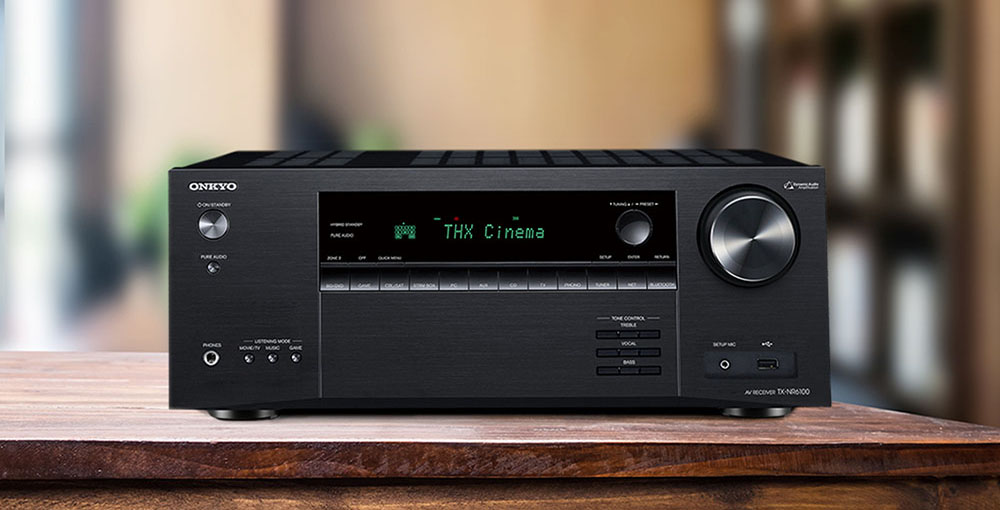
The Onkyo TX-NR6100 is the best 7.2 channels AV receiver they have at the moment and sits right above the entry level TX-NR5100 which is also a 7.2 channels release and below the top TX-NR7100 which is the only 9.2 channels unit they have available in this series. The TX-NR6100 seems to sit comfortably at a price level that is affordable and at the same time can offer a generous amount of extra features to make it a good option for a wide variety of systems.
But before we go in depth let’s see quickly what the TX-NR6100 has to offer. As we mentioned this is a 7.2 channels AV receiver with 100 watts of power per channel, is THX certified as with most Onkyo units and supports both Dolby Atmos and DTS:X. As for the rest we find an extensive list of extras including HDMI 2.1, USB and Bluetooth playback, Airplay 2, Chromecast, DTS Play-Fi, Sonos intergration, Roon, Spotify Connect and many more. The unit comes with Onkyo’s AccuEQ calibration system while it belongs in the first batch of new releases that feature bug-free HDMI 2.1 ports that plagued all 2020 AV receivers.
Overall the TX-NR6100 surely looks to have less features on paper than what we had seen in the TX-RZ50 but this was to be expected. It belongs to a completely different category but the unit still manages to offer a whole lot for its price tag. Is it really as good as it seems? Keep reading to find out…
Design
As per usual with almost all AV receiver manufacturers, Onkyo has been recycling the design of their new units from the previous years. In a similar fashion the TX-NR6100 seems to be borrowing its looks from the TX-SR494 with some slight alterations here and there. In terms of size the NR6100 measures 17 1/8˝ x 6 13/16˝ x 14 15/16˝ (435 x 173.5 x 379.5 mm) and weights 21.6 lbs. (9.8 kg) which is typical for this category.
As for the TX-NR6100 specifically, it has this squarish black box looks and features the same straight lines and sharp corners most of Onkyo’s AV receivers come with. Again there is no knob for input selection that we see in so many other models and Onkyo instead uses dedicated buttons for each input. Now if this is more practical or not is certainly a personal matter as some surely will prefer it than the usual input knob.
On the front face a big turning knob is placed on the right for the volume, a big central display showing all functions sits at the upper center, a circular power button on the left with a pure audio button below that while at the bottom left corner we find the headphones jack along with three small circular buttons for the listening modes and on the lower right corner, in a small inset, there is the microphone port along with a USB port. Unfortunately no front HDMI port here which is a real shame.
Under the central display we get a single thin line with three buttons on the left and three on the right for various functions while below these we get a thicker line with 12 buttons for the inputs. Lastly below these we get a group of 6 buttons with which you can control the treble, bass and vocal sounds.
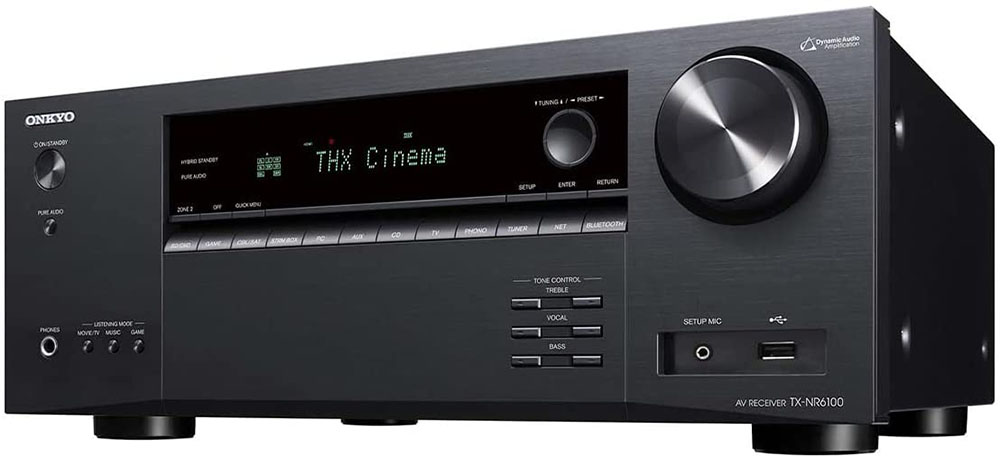
The TX-NR6100 may not be the cream of the crop but still Onkyo has carefully designed its internal components in order to perform according to their usual standards.
Therefore we find a custom high-current low-noise power transformer and large custom-made audio-grade power capacitors. Along with its isolated network module which reduces high-frequency interference on audio circuitry there is also a 2-stage non-phase-shift amplifier circuitry with discrete output stage.
As for its electronics we get the usual which means we once again find the PLL (Phase Locked Loop) anti-jitter technology for SPDIF audio, VLSC (Vector Linear Shaping Circuitry) noise filtering for the front left and right channels and precision 192 kHz/24-bit DACs for Hi-Res Audio.
As for the remote the one in the TX-NR6100 is exactly the same as the one we used in the TX-RZ50 and is basically the same one we had seen in some previous releases from Onkyo as the TX-RZ840. The remote is code named RC972R and it’s the typical, cheap looking plastic design that looks much lower quality than it really is.
The top includes all the input and playback buttons needed, in the middle we get the usual navigation buttons while at the bottom there are various audio functionality ones. The buttons are fairly large and have the familiar rubber feel to them. Unfortunately there is no backlight included which makes it harder to use it in the dark.

Onkyo may had a few misfires in the previous years but in general when it comes to the quality of their receivers they were always of a certain level. The TX-NR6100 surely looks and feels cheaper than the TX-RZ50 but this was to be expected as the NR6100 belongs in a completely different category and this reflects upon both its look and its internal components. Here the remote doesn’t feel so much out of place and the more affordable price justify its presence. One thing that we do hate is that there is no front HDMI port which we find so much useful and we would love it to be included no matter the price category.
Audio Quality
The receiver supports the usual Dolby Atmos and DTS:X formats along with their legacy cores including Dolby Digital, Dolby TrueHD, DTS and DTS-HD Master Audio. Unfortunately being a low to mid-tier release means that we don’t get either IMAX Enhanced or Auro-3D which was to be expected but honestly you don’t loose much and going for such a receiver most probably means that you wouldn’t use these anyway.
When it comes to up-mixing tech we find the usual Dolby Surround and DTS Neural:X. What these up-mixing tech are doing is to up-convert stereo and legacy mixes in order to make use of all the speakers you have in your setup. The receiver also supports the relatively new Dolby Atmos Height Virtualizer, which starts to become a standard lately, which can create a virtual setup and give you the illusion of audio from places where there are no real physical speakers. Along with Dolby’s Virtualizer we get DTS Virtual:X which does exactly the same thing for DTS mixes but keep in mind that this doesn’t work if you have height speakers connected.

The TX-NR6100 comes with 7 channels of built-in amplification rated at 100W per channel (8 ohms, 20 Hz–20 kHz, 0.08% THD, 2 channels driven, FTC). Obviously if you connect more than two speakers this number goes down but as always, by how much no one knows unless you make specific measurements.
With the available built-in amplifiers you can create a Dolby Atmos system up to 5.2.2 channels. If you don’t care about Atmos then a 7.2 channels system can be created. Keep in mind that if you want to use the Zone 2 capabilities of the receiver and connect a pair of speakers to another room this will limit the number of channels available in the main zone to 5.2 channels.
For our first test we chose Jurassic World in 4K UHD with its excellent DTS:X track. The Onkyo provided very distinct atmospherics in various scenes. When in the control room all the beeps, clicks and electronic sounds were clear and with high detail. Dialogue was front and center and was nicely confined in the center channel. But it was mostly in the jungle scenes where immersion took a high note as there were so many little sounds that made the experience all the more believable.
Dinosaurs are the main attraction and the NR6100 did a great job at portraying the size and weight of these amazing animals. Their growl felt raw and natural, the heavy steps of the T-Rex would shake our walls and the calling of the velociraptors sent chills down our spine.
Surround activity was great with a lot of audio emitting from the back speakers giving us a good idea of the action happening behind us while the overhead layer, even though not so active as in some other films, did add this little extra to the whole performance by extending the immersion bubble just a little bit more.

Next we tried out Man of Steel in 4K UHD which uses an impressive Dolby Atmos mix. The opening scene with the battle of Krypton was impressive as ever although with only two height speakers we did miss a bit in separation and panning clarity on the overhead layer. The battle of Superman and General Zod was the other highlight of the film and the Onkyo managed to offer good panning effects with precision, good transitions and no obvious delays between the channels.
Such a film obviously offers a lot of low end activity and the NR6100 had no trouble sending all the low end information to our subwoofer with masterful precision and energy. The film may be a good opportunity for trying out the receiver’s all out mayhem capabilities but it can be equally impressive with more delicate moments if the scene asks for it. Some countryside scenes would reveal a lot of small details like insects flying around and crops moving to the wind, really pulling you in the scene.
Obviously we wouldn’t be able to do without some Lord of The Rings action so this time we pulled our Return of the King UHD for some Minas Tirith destruction. The ride of the Rohirim really brought tears to our eyes as countless horses were galloping towards an endless orc army. The entire siege of Minas Tirith sequence is so grand in size and magnitude that it was impressive how good the Onkyo was able to render everything and throw you in the middle of the action.
Again all dialogue was nicely confined in the center and there was no overlapping with the rest of the sound effects. Surround and overhead effects were present but in a more subtle manner here. They would add to the whole scenery but never became so obvious as the film tends to be more front oriented.
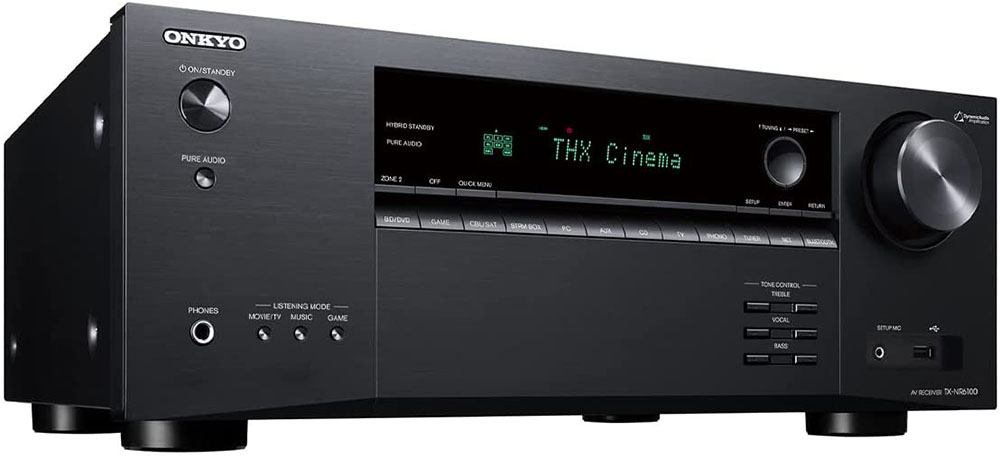
For our last test we tried Matrix Reloaded in 4K UHD which comes with a nice Dolby Atmos track. The motorway chase was the obvious scene to try out and what an amazing scene this remains even so many years after its release. The receiver nicely combined the panning effects as cars would pass by in high speed with Don Davis bombastic soundtrack.
Low end action was constant with car wrecks flying all over the place like a nicely choreographed ballet as Agents were trying to catch Trinity and Morpheus. Here the surround activity was through the roof and really showed both the mixer’s mastery and the receiver’s capable handling of such a demanding scene.
Closing this part of our review what we can say is that the Onkyo TX-NR6100 is every bit as capable as any other good quality receiver we have tested before. Yes, it may be lacking a bit in the overhead layer as it can do only two channels but for its price we cannot complain. It has enough energy, good details, clarity and it can be both rough and delicate depending what each scene asks for.
Last part of our testing was music so we switched to a 2 channels setup and got some tunes to stream through the USB port of the receiver. Since the units supports it we opted for some FLAC files we have in our collection just for tests like these.
What we say all the time is that while AV receivers may not be the ideal choice for those looking for the best musical experience they do have their merits and can be a good solution mostly for those that are looking to get one for mixed use. And the TX-NR6100 is no different here.

Overall sound output was great with a very natural tone to it and good balance in the frequency spectrum. Onkyo receivers may not be as musical as Marantz but the difference is so small that for most people it will most probably go unnoticed. The mid-range was balanced enough, the high end had enough vibrancy and pleasing energy without being intrusive while the low end kept the tempo and had the necessary oomph to it.
Good transparency overall and nice panning effects during certain performances showed how capable the receiver was with stereo mixes. After testing various genres like pop, rock, country, electronic and classical music we didn’t notice any particular problems overall with the receiver being very stable and capable handler of all kinds of content.
Overall the Onkyo may not be the ultimate in musical fidelity but it will do nicely in a setup where movies and music playback have to coexist. And this is one of the main reasons why a lot of casual consumers will certainly choose it for.
Overall the receiver will not disappoint you. Either you want it just for movies or for mixed use the NR6100 will handle everything nicely and for the price asked we believe that Onkyo has a real winner here. Obviously hardcore audiophiles and home theater fanatics have other options to choose from but for the more casual market this one is a no brainer really.

Ports and Connectivity
One thing we loved in the TX-RZ50 was the inclusion of a front HDMI port which is such a huge practical feature. Unfortunately in the TX-NR6100 this has been taken out so the headphones jack along with a single USB port and the setup mic port are the only available ones at the front side. Everything else is placed naturally at the back of the receiver.
The TX-NR6100 comes with 9 speaker terminals but only 7 of them can be used in the main zone and the other 2 are meant for Zone 2. There are also 6 HDMI inputs and 2 HDMI outputs, enough for most simple or complex setups. Here you should keep in mind that only HDMI 1-3 are the newer HDMI 2.1 while the other 3 are the older HDMI 2.0.
As for all the rest of the ports available we find 4 analog ports with one more dedicated to phono, one optical and one coaxial digital audio input, 2.2 multi-channel pre-outs, an Ethernet port, another USB port and the usual FM/AM ports along with the dual WiFi/Bluetooth antennas at the top.
Probably one of the most interesting, and important at the same time, aspect of the TX-NR6100 is the included HDMI 2.1 ports that it uses. All the 2020 AV receivers that featured HDMI 2.1 came with a bugged Panasonic chip that wouldn’t allow it to pass certain signals, like 4K/120Hz RGB signals from the Xbox series X for example as it would result in a black screen.
The TX-NR6100, along with all the latest releases from Onkyo, seems to be using an updated version of this Panasonic HDMI 2.1 chip which allows up to 40Gbps of bandwidth in three of its HDMI ports and this includes all the signals with a 4K@120Hz configuration including Xbox Series X.
Although we had tested this before with the TX-RZ50 we did connect an Xbox series X and our test TV indicated that we were getting 4K@120Hz with VRR at 40Gbps signal bandwidth once again. During this test we didn’t experience any HDMI problems and the signal was completely stable throughout the playing session.
The HDMI ports of the TX-NR6100 support 8K/60p(4:4:4/12-bit, 4:2:2/12-bit, 4:2:0/10-bit), 8K/30p (4:4:4/12-bit, 4:4:4/10-bit, 4:2:2/12-bit), 4K/120p (4:4:4/12-bit, 4:4:4/10-bit, 4:2:2/12- bit) video passthrough, VRR, ALLM, QFT (Quick Frame Transport), DSC (Display Stream Compression), QMS (Quick Media Switching), eARC (Main Out), HDR10+, Dolby Vision, HDR10, and HLG, BT.2020 color, DeepColor, x.v.Color, LipSync, and HDCP 2.3.
As for its wireless capabilities there is built-in WiFi (802.11ac) to connect to wireless and local networks while it also supports Bluetooth streaming. The TX-NR6100 comes with Bluetooth 4.2 but the most interesting aspect of its Bluetooth capabilities is that other than the usual SBC transmission the Onkyo has also included AptX along with AptX HD transmission which is not something we have seen in most other commercial AV receivers.

Having HDMI 2.1 without the infamous bug is a breath of fresh air honestly. And having 3 of these ports means that most probably you will be ok for the foreseeable future making the TX-NR6100 an excellent choice if you are not the kind of person that upgrades too often.
OS, Apps and Features
The NR6100 may not belong in the premium category but surely comes with a beefy list of extras and features. The list is very similar to what we saw included in the TX-RZ50 but there are a couple of omissions here and there and we will mention them as we go.
First of all we will talk about its calibration system and here we find the first big difference compared to the TX-RZ50. Until recently all Onkyo AV receivers were using Onkyo’s proprietary AccuEQ calibration system. With the TX-RZ50 Onkyo, for the first time, introduced the addition of Dirac Live along with their own AccueEQ one. Unfortunately the TX-NR6100 is missing this fan favorite calibration system but the available AccueEQ system is good enough considering the category this receiver belongs to.
The AccueEQ auto calibration system, as with all similar systems from the other brands, can be scaled according to the price class of the receiver. As such the one we find here is the AccuEQ with AccuReflex and Subwoofer EQ. The system detects speaker size, crossover frequency, and distance from the listening position and sets appropriate sound-pressure levels. It also sets crossovers and EQs to all speakers including the subwoofers.
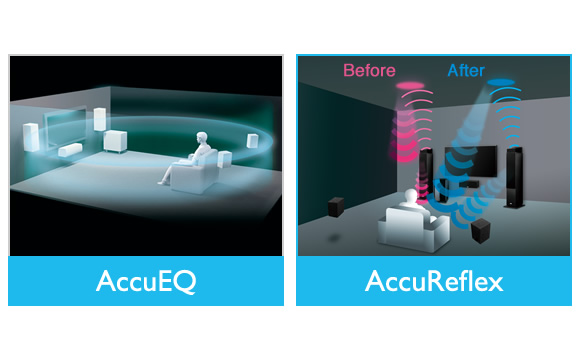
AccuReflex on the other hand optimizes 3D sound through Dolby Atmos-enabled speakers by correcting phase differences in directional and non-directional sound-paths in order to have a clear and cohesive sound-field.
In terms of controlling the receiver the TX-NR6100 is not missing anything. So except from the remote you can also download the Onkyo Controller App that is free for both Android and iOS and provide all the options and menus you will ever need both for the basic functions but also if you want to stream music from the receiver. The app is pretty good, we recently had tested it in our TX-RZ50 review and in terms of functionality it is the same with this receiver.
But any new receiver couldn’t be without some form of voice control support. As such the unit supports not only Google Assistant but also Amazon Alexa, which by the way was missing in the previous AV receivers lineup from Onkyo, but you will need an external device for these to work obviously. If on the other hand you are mostly an Apple guy then fear not as Siri is also included in the mix and can be used through the Airplay 2 app.
But if all these are too high tech for you and you still prefer to have a remote in your hand Onkyo has provided the unit with HDMI-CEC so you can use your TV’s remote in order to control the receiver and this way you can reduce the amount of remotes you have to use at once. This way does not provide full control of the AV receiver but for some basic commands it can be useful and very practical.

The user interface is nothing to brag about but one thing we need to mention is that Onkyo is providing a slightly better one compared to what we still get in Denon and Marantz models. It’s not anything fancy and we are still very far from what smart TVs offer in their UIs but at least it is much more pleasant to the eye and doesn’t look like something that was created in the 90s.
Streaming services could not be missing obviously and so we find the most usual names including Amazon Music HD, Pandora, Spotify, TIDAL, Deezer, and TuneIn among others. In addition you can also stream music locally if you have a network hard drive or NAS server connected to your local network.
The TX-NR6100 is equipped with an isolated 1.8 GHz quad-core SoC that is capable of performing multiple processing tasks at once. It evolves network functions and supports the 802.11ac (2×2 MIMO) standard for stable multi-room audio streaming either this is made through a wireless and wired connection.
You can also stream music by connecting an external hard drive on either the front or the back USB ports available. The receiver supports a wide range of audio files including the usual mp3, wma and aac while it can playback High Resolution Audio also in the likes of FLAC, AIFF, WAV and DSD. In general we found that the built-in support was pretty good and there were no files that we tried that didn’t play correctly or had any playback issues.

Additionally you can stream music through a Bluetooth connection from any kind of appropriate mobile device while if you are using Apple devices you can do the same by using the Airplay app and stream music from all kinds of Apple devices. But the NR6100 comes with more enhancements to its Bluetooth capabilities as you cannot only send audio to the receiver itself but it can also transmit to some Bluetooth device either to it alone or in a Main Speakers plus Bluetooth device configuration.
And although this is a feature some of the other brands also utilize what seems a first in such commercial AV receivers is the addition of aptX and aptX HD codecs, as we mentioned above, for far better streaming quality except from the usual SBC we have seen being widely used. Just keep in mind that the headphones must also support aptX for this to work, otherwise the simple SBC codec is used.
Another particular handy feature is the inclusion of a low latency mode. We had tried using the Bluetooth transmission feature but when watching a movie there is obvious lip sync issues due to the slow transmission of the SBC protocol. With Onkyo including a low latency mode in the NR6100 means that streaming to some Bluetooth headphones will sync the audio exactly to what is on screen.
All of Onkyo’s previous releases had strong multi-room capabilities and the NR6100 is no different. There is support not only for Chromecast that allows you to connect other Chromecast enabled speakers in your house to the receiver but also DTS Play-Fi and Airplay 2 if you are mostly using Apple devices while it even has “Works with Sonos” integration. And adding to all this you will also find support for 2 multi-zones (Zone 2, Zone B) as an added feature.

The receiver is also “Roon Tested” certified but here we need to make clear that there are two types of certifications and many people don’t know the difference between them. The two types of certification are Roon Ready and Roon Tested.
The TX-NR6100, as with most other AV receivers from competing brands, is Roon Tested which means that it doesn’t have Roon built-in but has been tested to work but not without a small catch. And that is audio quality. As this works through some streaming system like USB, HDMI, AirPlay, Google Cast or other protocols, audio quality is limited to only 16 Bit/44.1kHz. Keep that in mind in case Roon is specifically important to you but also want your files to be streamed in their original high quality.
We should mention that Onkyo is one of the few brands that still has their AV receivers THX certified. And although being a THX product doesn’t have the weight it had a few years back it is good to see a low to mid-tier receiver as the TX-NR6100 bearing this certification.
Before closing there are a few more features worthy of mentioning including IP Control for setup via PC and integration into a home automation system, Advanced Music Optimizer which improves compressed audio playback quality and 1080p to 8K/4K video upscaling via HDMI.
From all the above what we can say is that in terms of features the NR6100 is not missing much from its more premium brother. Yes, there are a couple of omissions here and there with the biggest one being the missing Dirac Live but as for everything else the differences are very small making the TX-NR6100 an excellent choice which will give you a lot of options and freedom to use it the way you want.

Final Thoughts
Onkyo has done so many things right with their latest releases and the TX-NR6100 is another example. As a whole it may not impress as much as the TX-RZ50 we tested recently but keep in mind that the NR6100 comes at a much lower price and is targeted to a completely different part of the consumer market. Being a direct replacement of the award winning TX-NR696 of 2019 the NR6100 tries to find a better balance between price and features in contrast to the RZ series which aims mostly for the enthusiast market.
The TX-NR6100 comes with a build quality and design that is typical of Onkyo, its audio output and overall performance was great and the number of features available will surely keep most people looking for an affordable 7.2 channels receiver more than happy. Having the newer HDMI 2.1 ports that are bug free is a huge plus making the NR6100 along with the rest of the new releases future proof which is very important if you don’t change your audio equipment very often.
As for its downsides the TX-NR6100 may feel slightly more expensive especially with the Yamaha RX-V6A being priced lower than the Onkyo but there are some features that the Yamaha is missing so the price difference may be justified. Then we have exactly the same problems as the ones we mentioned in our TX-RZ50 review as the TX-NR6100, as with all Onkyo products, is very hard to find. Most stores are out of stock so you have to be lucky to find a unit available. Also the remote definitely needs an upgrade even if the lower status of the NR6100, compared to the RZ50, may justify such one.
As a final word the Onkyo TX-NR6100 is a very capable AV receiver if you are looking for a 7.2 channels unit with great audio output and plenty of online and offline features at a price that will not break the bank. It is an excellent choice either you are a casual or more advanced user and will offer you a very satisfying cinematic experience for many years to come.
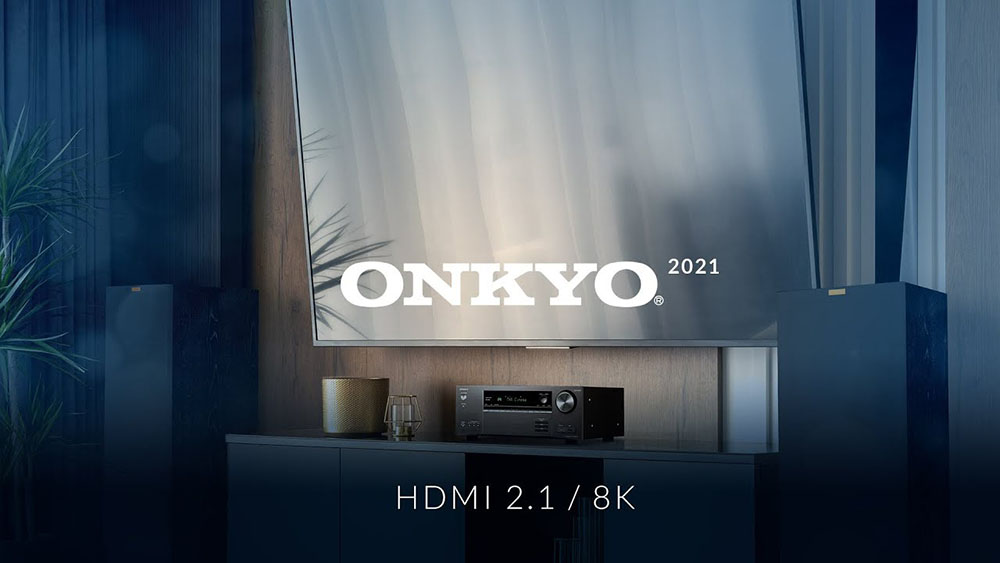
For more reviews you can check our dedicated 7 channels 8K AV Receiver reviews list or even look at our Product Reviews Table where you can find the brand and specific product you are looking for.
Cheapest Places to Buy :
*We are a reader-supported website. When you buy through links on our site, we may earn a small affiliate commission at no extra cost to you. Home Media Entertainment does not accept money for reviews.*
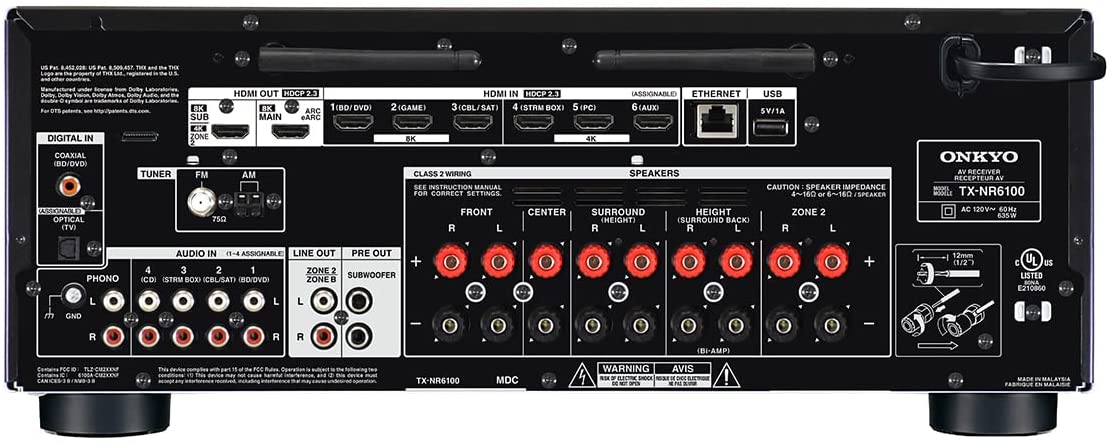
The NR6100 may not be a high-end model, but it is good enough to enjoy cinema at home. For me, 5.1.2 channels is more than enough and I wouldn’t be able to add another pair of height speakers anyway. I’m still using an old Denon model and I am toying with the idea of upgrading, and this one seems interesting. Thank you for such a detailed review!
You are welcome Kim. If you need any further assistance let me know in the comments.
I was looking at the latest Onkyo releases and was thinking to get the 6100 but it is damn hard to find one available. They seem to be out of stock all the time. Onkyo must step up their game when it comes to distribution and availability. Cheers for the great review!
Indeed it’s hard to find any of the latest Onkyo releases. And it seems there are a lot of people looking out for them. Let’s hope things will improve in the near future because it’s a shame to have so good products but none available for purchase.
If you search for the TX-NR6100 on Amazon, it doesn’t show up in a search for some reason…
But here is the direct link to it on Amazon and it’s in stock:
https://www.amazon.com/gp/product/B09LH9XZJ5/
Indeed for some reason Amazon does not show the NR6100, only the NR6050. But your link works so I added it with the others. Thank you very much!
Thanks for the review!
Have one question: how did you get the information about the bandwidth speed? At the TV, the receiver or at the Xbox?
” …and our test TV indicated that we were getting 4K@120Hz with VRR at 40Gbps signal bandwidth once again…”
Thanks!
Hello Mario. LG TVs show detailed information about the incoming signal. It’s the easiest way to see this.
Thanks!!
Was wondering about the quality of DACs they are using in the new models. They seem too have down graded from 384khz/32-bit to 192 kHz/24-bit.
Hey Tristan. Indeed this seems to be the case. Some previous Onkyo AV receivers were using the AKM (AK4458) 384 kHz/32-bit DAC but not anymore. Now how much of this difference is audible is questionable. But either you can hear the difference or not the downgrade is a fact from the specs.
Is the 6100 a better receiver than the earlier 696 model? Thanks.
Hello Murray. I would say they are very similar. But they have some differences as the 6100 has higher power output and HDMI 2.1 ports while on the other hand the 696 seems to have better DACs (384 kHz/32-bit vs 192 kHz/24-bit of the 6100).
Last few days I bought Onkyo TX NR6100 and with various demos I was impressed. The sound through streaming it delivers was astonishing…
Hello Alex. Thank you very much for your comment and input. I am glad you are happy with it. If you need any help don’t hesitate to write us.
Hello there, is tx nr 6100 + 24pcs banana type plug + 100ft speaker wire, available here. Thanks
Hello Fernando. I cannot fully understand what you want to say with your comment. DO you care to elaborate? Thanks.
Being this is later in 2023, do you see this as a viable solution still? For the price point right now (on sale) I’m just wondering since its a 2020 receiver, I hate possibly not having the latest options and maybe a little future proofing, But as of right now it seems to have them, what’s your opinion, Thanks!
Hello John. First of all the Onkyo TX-NR6100 was released in 2021 and not 2020. But I think that you are missing the point here. It doesn’t really matter if the receiver was released in 2010, 2020 or 2023. What you should really ask yourself is if it has what you need. Because in the end this is what you pay for. In my opinion you should make a list of all the features you want and then look at what is available in the market that supports these. Then based on their price, specs and performance you can make your decision. The release date is the last thing I would look at a product like this.
Now, obviously I cannot say if the NR6100 is your best choice since I have no idea what you need and what you are looking for. But if you want to give me more information I will be glad to help you make up your mind.
Well it seems the other receivers I was looking at are made in 21 or 22, My Denon has 120watts/channel, and it seems for the price point I am at, that 100watts is the sweet spot. I am looking for a very musical receiver, with the ability to do nice surround, though not a lot of time at either. I am trying to upgrade my current speakers so that I can enjoy Dolby Atmos with a couple of upfiring speakers on my rears. I have a newer 77inch LG C3 OLED so I was concerned about the pass-through for my 4k blu-ray player. This newer tech is all new to me, So the TV pass through and newer surround options were the driving force as well as decent wattage to power my speakers. My choices on receivers were as follows; Denon avr-s970h, avr-x2700, Yamaha rx-A2A, and this Onkyo. I’m not really an Audiophile, though listening to the cheaper Yamaha and the cheaper Denon, I can definitely hear the soundstage difference. But I have yet to be able to hear this Onkyo. How do you feel this compares to these other receivers? Back in the day when I got the Denon, the Onkyo was the cats meow, but after they sold the last one locally, trying to get one became a problem so I bought the Denon. Also thanks for any and all advice and answering!
Also forgot to mention that the cheaper models mentioned above were the Denon s-760h and the Yamaha RX-V6A, and it seems the Yamaha RX-A2A sounds better than either Denon.
Personally I would go for either the Onkyo or the Yamaha. As for comparing the V6A vs the A2A in the closing section of my A2A review I mention all the differences these two have. They are extremely similar and it really depends on if you can justify the added price for what extras you get.
So my first choice would be the NR6100 and if I couldn’t find it I would go for either the V6A or A2A.
Thanks again for the advice, Onkyo it is…appreciate it!
Anything else you need John don’t hesitate to write in the comments. I will be glad to help you.
Hi just a update and maybe a little advice. I ended up getting a Denon s970h on a steal of a deal, (<500) but I am finding that it just doesn't seem to get up to volume without some distortion. It's 90w a channel and I thought it would be enough but it seems I was wrong. My question is and maybe you could steer me, The Onkyo NR6100 has 100watts and the Yamaha RX-a2a as well, though I can get nR6100 on a deal and the Yamaha for a few hundred more. I was thinking about the Yamaha Rx V6a but having a chance to hear it and the RX-a2a side by side, there was a noticeable difference (at least for me). So now I am stuck between the Onkyo NR6100 and the Yamaha RXa2a, but In the Onkyo line I hear so much about the TXRZ50 and it seems in the same class as the RXA2A, do you think I should try to find a deal on it? Just not sure if the nr6100 will have enough juice for me. The guess the kicker is sometimes I can blast it up a bit when the wife is gone and I love a nice clean loud sound, and kind of used to that from my old Denon AVR-3806. It seems the TXRZ50 can be around the price of the Yamaha a2a and with a deal pretty close. I know I might end up paying a bunch more but maybe if I found a deal it would be worth it in the long run.
Thanks again sir, as always I appreciate the advice and input
Hello John. If you can find the RZ50 (good luck with that) and your budget allows for it then definitely go for it, no questions asked.
Thank You!! It’s nice to know you have heard all of these and know the stats, sound, etc…something we can’t match.
I appreciate the help and insight.
John
No problem John. If you need anything else let me know.